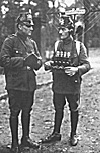 Doctrinally, a troop would delay
on a regimental avenue of
approach. But to do that mission
in a fixed position, such as a town, would
be a high risk delay, and I donít think you
could do it for an entire day.
Doctrinally, a troop would delay
on a regimental avenue of
approach. But to do that mission
in a fixed position, such as a town, would
be a high risk delay, and I donít think you
could do it for an entire day.
H.R. McMaster wiped out an Iraqi reinforced motor rifle battalion, tanks, IFVs and all, at the battle of 73 Easting. These are not doctrinal results, and H.R. didnít exactly employ doctrinal methods to achieve those results -- unless you look at the surprised Iraqi defenders as mounting an ambush !
The M60A1 was only inferior to the T72 in terms of mobility, not lethality. It was probably better armored, but only to the front. With the onset of depleted uranium munitions in the US Army, the problem of penetrating T72 frontal armor at medium to long range was solved. The Soviets had the same debate with respect to BMP survivability that we had with the Bradley.
If you want to think disinformation, consider this. Tactics instruction in the US Army is mostly done at the unclassified level. Those classes were filled with officers from ďalliedĒ armies like Somalia and Pakistan. I even had an Indian major in one of my classes. Iím not going to tell you that we taught bogus weapons capabilities in those tactics classes, or that we wrote them into our field manuals. This is something I never discussed with anyone.
But the historical results of Desert Storm suggest that our munitions were considerably more lethal at longer ranges than suggested in the defense chapter of FM 71-1 (1988), which I wrote.
What we did not have in those waning days of the M60A1 tank was sufficiently well-trained crews to get first round hits with the coincidence range finder. Due to training area limitations, I and my crews were excellent shots within battlesight range. My more experienced tank commanders could hit that 1800 HEAT engagment with the gas mask on that separated the aces from mediocre shots like yours truly on Table VIII. I never did.
In the M60A1 tank company I commanded, the standard procedure in a precision engagement was for the tank commander to range to the target, and announce range to the gunner, who used the telescope (not the primary sight which is slaved to the rangefinder) to engage the target at the prescribed range.
The reason they did this -- contrary to doctrine -- was the belief that the primary sight was mechanically unreliable. But I donít think this mattered as much as firing Sabot, which has a much flatter trajectory.
But when we went over from the coincidence rangefinder to the M60A3 laser rangefinder, no problem. As long as the tank commander and gunner were up to the demanding time standards, getting rounds on target was a snap. As defensive tanks go, the M60A1 was perfectly suitable to the task it was given. There was a lot of gnashing of teeth amongst cavalry and armor types because it is terribly hard to conduct a delay with tanks that have to kill their opponents between 1000 and 1500 meters.
My own view, which I tried to weasel in to the manuals, is that you kill the attacking echelon at whatever range, and then you disengage. If you try to disengage while the enemy is assaulting the position you are about to withdraw from (whether or not you have an overwatch covering your move), that is a big risk, and youíd be better off staying put. To put it another way, cavalry people, I donít believe in break points. In FM 71-1, I tried to emphasize killing the attacking force in prebattle formation before it begins the assault. The best of the cavalry manuals say much the same thing.
Mike asked, ďwhat kind of interest is there in NATO/WP hot war games anymore?Ē
I for one am very interested in a NATO/WP game using information the West learned after the fall of the Soviet Union. In the immediate Post Cold War period, information the CIA would have gladly paid millions for was available for a pack of cigarettes, yet few cared. Now much of that information is in land fills or is recycled. Decision Games collected much of this information while the getting was good. They used this data to design a wargame, but have been very uncertain about the level of interest in such a game, so have gone back and forth on spending the money to publish it. If you share my interest let them know -- maybe they will finally get into print.
Much of the research was done by a now retired Col. Don Alexander. At the time he was on the staff of (I think it was) V Corps. On leave, he ran across literally pounds of abandoned plans and documents, and could not interest his military supervisors in what he found. He and Bill Gibbs developed the game about 10 years ago and have been debating if there is enough interest to risk their money to publish it ever since. I donít know how well they did air but both of them have an outstanding grasp of ground operations, so Iíve been impatiently rooting for them to publish for something like a decade.
Back to Simulacrum Vol. 4 No. 4 Table of Contents
Back to Simulacrum List of Issues
Back to MagWeb Master Magazine List
© Copyright 2002 by Steambubble Graphics
This article appears in MagWeb (Magazine Web) on the Internet World Wide Web. Other articles from military history and related magazines are available at http://www.magweb.com